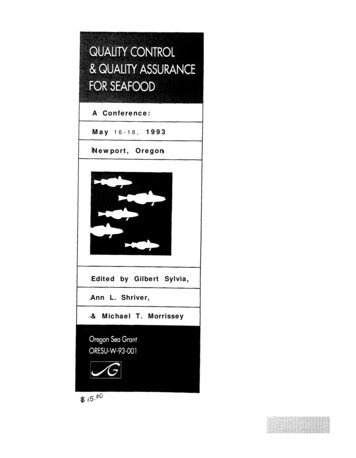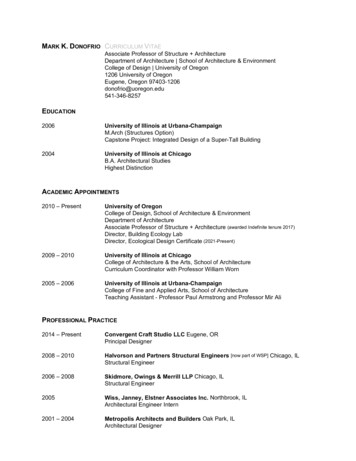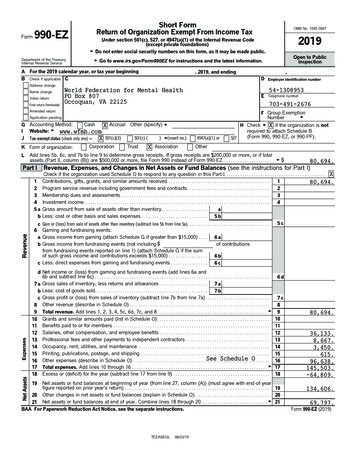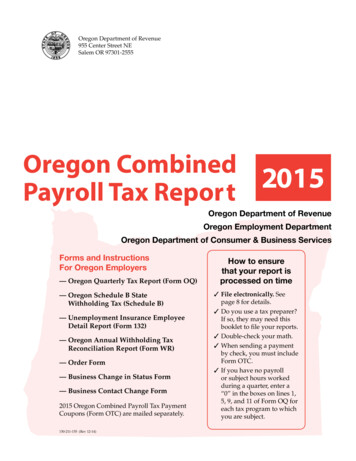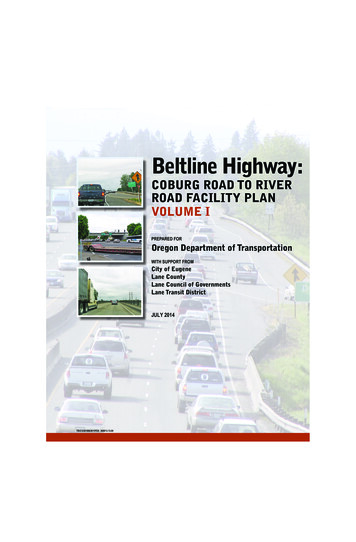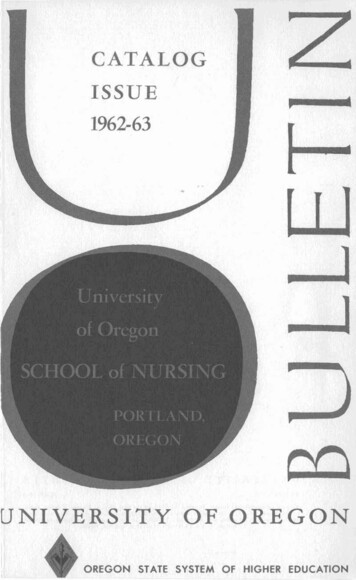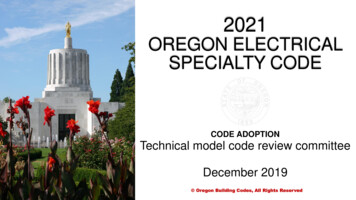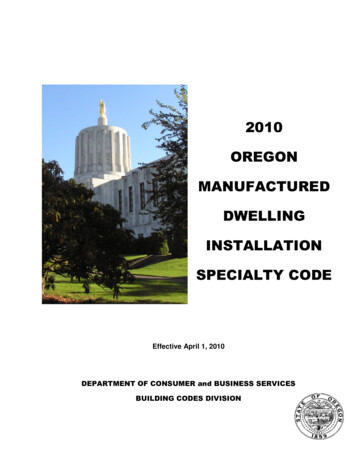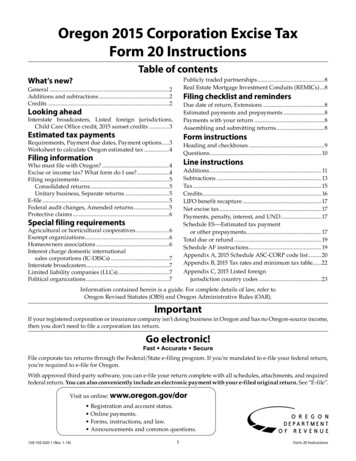
Transcription
Oregon 2015 Corporation Excise TaxForm 20 InstructionsTable of contentsWhat’s new?Publicly traded partnerships.8Real Estate Mortgage Investment Conduits (REMICs).8General .2Additions and subtractions.2Credits .2Filing checklist and remindersDue date of return, Extensions.8Estimated payments and prepayments.8Payments with your return.8Assembling and submitting returns.8Looking aheadInterstate broadcasters, Listed foreign jurisdictions,Child Care Office credit, 2015 sunset credits.3Estimated tax paymentsForm instructionsRequirements, Payment due dates, Payment options.3Worksheet to calculate Oregon estimated tax.4Heading and checkboxes.9Questions. 10Filing informationLine instructionsWho must file with Oregon?.4Excise or income tax? What form do I use?.4Filing requirements.5Consolidated returns.5Unitary business, Separate returns.5E-file.5Federal audit changes, Amended returns.5Protective claims.6Additions. 11Subtractions.13Tax.15Credits. 16LIFO benefit recapture.17Net excise tax.17Payments, penalty, interest, and UND.17Schedule ES—Estimated tax paymentor other prepayments.17Total due or refund.19Schedule AF instructions.19Appendix A, 2015 Schedule ASC-CORP code list.20Appendix B, 2015 Tax rates and minimum tax table.22Appendix C, 2015 Listed foreignjurisdiction country codes.23Special filing requirementsAgricultural or horticultural cooperatives.6Exempt organizations.6Homeowners associations.6Interest charge domestic internationalsales corporations (IC-DISCs).7Interstate broadcasters.7Limited liability companies (LLCs).7Political organizations.7Information contained herein is a guide. For complete details of law, refer toOregon Revised Statutes (ORS) and Oregon Administrative Rules (OAR).ImportantIf your registered corporation or insurance company isn’t doing business in Oregon and has no Oregon-source income,then you don’t need to file a corporation tax return.Go electronic!Fast Accurate SecureFile corporate tax returns through the Federal/State e-filing program. If you’re mandated to e-file your federal return,you’re required to e-file for Oregon.With approved third-party software, you can e-file your return complete with all schedules, attachments, and requiredfederal return. You can also conveniently include an electronic payment with your e-filed original return. See “E-file”.Visit us online: w ww.oregon.gov/dor Registration and account status. Online payments. Forms, instructions, and law. Announcements and common questions.150-102-020-1 (Rev. 1-16)1Form 20 Instructions
unless otherwise included in Oregon taxable income[ORS 317.715 (2013)].What’s new?Use the subject corporation’s net income or loss asreported on line 18, Schedule C of federal Form 5471.Report each subject corporation’s income or loss as aseparate amount on Schedule ASC-CORP, Oregon Adjustments, 150-102-033. Don’t combine amounts of multiplecorporations.GeneralTie to federal tax lawIn general, Oregon income tax law is based on federalincome tax law. Oregon is tied to the federal definition oftaxable income as of December 31, 2014; however, Oregonis still disconnected from:If a subject corporation’s income has been excludedfrom your federal consolidated taxable income as carried to your Oregon return, it’s a positive “Other addition” [code 176]. If a subject corporation’s loss or item ofexpense has been excluded from your federal consolidated taxable income as carried to your Oregon return,it’s a negative “Other addition” [code 177]. Federal subsidies for prescription drug plans(IRC§139A; ORS 317.401). Domestic production activities (QPAI) (IRC §199;ORS 317.398). Deferral of certain deductions for tax years beginning on or after January 1, 2009 and before January 1,2011 may require subsequent Oregon modifications(IRC §108; §168(k); and §179; ORS 317.301).Listed foreign jurisdictions—previously includedamountsInterstate broadcastersIf any portion of a subject corporation’s income, loss oritem of expense was already included in your Oregontaxable income, it won’t be included again. If a portion ofincome was previously included, claim a separate “Othersubtraction” [code 367] for the portion of the income thatwas previously included. Don’t combine this amountwith the “Other addition” to report income. If any portion of a subject corporation’s loss or item of expensewas already included in your Oregon taxable income,reduce the “Other addition” loss for the portion that waspreviously included [code 177]. Include a schedule withyour return to explain how each amount is determined[ORS 317.715 (2013) and corresponding administrativerules].For tax years beginning on or after January 1, 2014, andbefore January 1, 2017, an interstate broadcaster’s apportionment will be determined based on the broadcaster’scustomers who are domiciled in Oregon. For tax yearsbeginning on or after January 1, 2017, the method ofapportionment of business income for the interstatebroadcaster will revert to pre-January 1, 2014 law andwill be based on an estimate of Oregon’s national audience or subscribers’ share (ORS 314.684 and 314.680).For more information, see “Special filing requirements.”Minimum tax can’t be offset by creditsFor tax years beginning on or after January 1, 2015, andbefore January 1, 2021, taxpayers may not apply any corporation tax credits against the minimum tax of C corporations. See “Credits” under “Line instructions” below.CreditsImportant: Corporations must include copies of all creditcertifications with your return when claiming any certified credit.For tax years beginning prior to January 1, 2015, all corporation tax credits, except for the “Contributions of computers or scientific equipment for research” credit, maybe applied against the minimum tax of C corporations.Individual Development AccountsThe Individual Development Accounts (IDA) contribution credit is extended to tax years beginning before January 1, 2022, and the annual total amount of credits is limited to 7.5 million. The fiduciary organization receivingthe donation determines the percentage amount of thedonation allowed for the credit, not to exceed 70 percent.The purposes for which the IDA money may be used arerevised (ORS 315.271).Exemption for emergency service providersAn out-of-state emergency service provider is exemptfrom tax when operating at the request of a registeredbusiness, solely for the purposes of performing disaster or emergency-related work on critical infrastructure.Disaster or emergency-related work conducted by anout-of-state business may not be used as the sole basisfor determining that a corporation is doing business inOregon.Oregon Health and Life Insurance Guaranty Association(OHLIGA) (Form 20-INS filers only)The OLHIGA credit is extended to tax years beginningbefore January 1, 2022. Insurance companies are alloweda credit against corporate income taxes for certain assessments paid to OLHIGA. Qualifying assessments are thoseused to cover the cost of claims against insurers who havegone out of business. The credit is taken equally over fiveyears (ORS 734.835).Additions and subtractionsListed foreign jurisdictions—income or lossTaxable income or loss of any unitary corporationthat’s incorporated in a listed foreign jurisdiction shallbe included in Oregon income as an “Other addition,”150-102-020-1 (Rev. 1-16)2Form 20 Instructions
Film production development contributions creditEstimated tax paymentsThe Oregon film production development contributionscredit is extended to tax years beginning before January 1,2024 (ORS 315.514).RequirementsOregon estimated tax laws aren’t the same as federalestimated tax laws. You must make estimated tax payments if you expect to owe tax of 500 or more with yourreturn. This includes Oregon’s minimum tax.Tax credit sunsetsBeginning January 1, 2015, the following tax credits areno longer available, except for applicable carryforwardpurposes:If you don’t make estimated payments as required, youmay be subject to interest on underpayment of estimated tax (UND). If you have an underpayment, referto Form 37, Underpayment of Oregon Corporation EstimatedTax, 150-102-037. Alternative fuel vehicle fund (auction) credit (Note following ORS 315.336). Mile-based or time-based motor vehicle insurancecredit (Note following ORS 317.122). Long-term care insurance (Repealed—ORS 315.610).Payment due datesEstimated tax payments are due quarterly, as follows:Looking ahead Calendar year filers: April 15, June 15, September 15,and December 15. Fiscal year filers: The 15th day of the 4th, 6th, 9th, and12th months of your fiscal year. If the due date falls on a Saturday, Sunday, or legalholiday, use the next regular business day.Interstate broadcastersFor tax years beginning on or after January 1, 2017, aninterstate broadcaster’s method of apportionment ofbusiness income will revert to pre-January 1, 2014 lawand will be based on an estimate of Oregon’s nationalaudience or subscribers’ share (ORS 314.684 and 314.680).Payment optionsImportant: For details about making payments with yourreturn, see “Filing checklist.”Listed foreign jurisdictionsFor tax years beginning on or after January 1, 2016, thelist of foreign jurisdictions that must be included in theOregon corporate excise tax return will change. The listwill include Guatemala and the Republic of Trinidadand Tobago. Monaco is deleted from the list. The list willalso be updated to include the island nations of Bonaire,Curacao, Saba, Sint Maarten and Sint Eustatius (formerlythe Netherlands Antilles) (ORS 317.715 and corresponding administrative rules).Estimated payments may be made by electronic fundstransfer (EFT), online, or by mail.EFT. You must make your Oregon estimated paymentsby EFT if you’re required to make your federal estimatedpayments by EFT. We may grant a waiver from participation in the EFT program if you would be disadvantagedby the requirement (OAR 150-314.518).If you don’t meet the federal requirements for mandatory participation in the EFT program, you may participate on a voluntary basis.Child Care Office contribution creditStarting with tax years beginning on or after January 1,2016, the calculation of the Child Care Office fund contribution credit is revised. The amount of credit is reducedfrom 75 percent to no more than 50 percent of the amountcontributed to the fund (ORS 315.213). Additionally, thecredit is extended to tax years beginning before January 1, 2022.A business is required to have an authorization agreement filed with us before it can start initiating EFTpayments. The EFT help/message phone number is(503) 947-2017.For more information, visit www.oregon.gov/dor/e-filing. EFT payments for corporation estimated taxes must bemade using our EFT program. This program allows payments to be initiated by phone, a secure internet site, orthrough your financial organization. If you pay by EFT,don’t send Form 20-V, Oregon Corporation Tax PaymentVoucher, 150-102-172.Credits currently scheduled to sunset onDecember 31, 2015 Dependent care assistance (ORS 315.204). Dependent care information and referral (ORS 315.204). Energy transportation projects (ORS 315.336). Qualified equity investment (ORS 315.533). University venture development fund contributions(ORS 315.521).150-102-020-1 (Rev. 1-16)Online. See www.oregon.gov/dor for more information.Mail. If paying by mail, send each payment with aForm 20-V payment voucher.3Form 20 Instructions
Worksheet to calculate Oregon estimated taxOregon source income. Public Law (Pub.L.) 86-272 provides exceptions to this requirement for certain corporations doing business in Oregon.(Keep for your records—don’t file with payment.)1. Oregon net income expected inupcoming tax year.1.2. Tax on Oregon net income (seeAppendix B).2.3. Subtract tax credits allowable inupcoming tax year.3.4. Net tax (line 2 minus line 3).4.Note: Oregon follows the federal entity classificationregulations. If an entity is classified or taxed as a corporation for federal income tax purposes, it will be treatedas a corporation for Oregon tax purposes.Excise or income tax?Oregon has two types of corporate taxes: excise andincome. Excise tax is the most common. Most corporations don’t qualify for Oregon’s income tax.If the amount on line 4 is lessthan 500, stop. You don’t haveto make estimated tax payments.Caution: If your final taxliability when you file yourreturn is 500 or more, you maybe subject to UND.5. Amount of each payment.(Divide line 4 by the number ofpayments you need to make.This is usually 4.)Excise tax is a tax for the privilege of doing businessin Oregon. It’s measured by net income. All interestis included in income, no matter what its source. Thisincludes interest on obligations of the United States, itsinstrumentalities, and all of the 50 states and their subdivisions. Excise tax filers are subject to corporate minimum tax. Corporation excise tax laws are in Chapter 317of the Oregon Revised Statutes.5.Income tax is for corporations not doing businessin Oregon, but with income from an Oregon source.Income tax filers aren’t subject to corporate minimumtax. Corporation income tax laws are in Chapter 318 ofthe Oregon Revised Statutes.If your expected net tax changes during the year, dividethe amended net tax amount by the number of requiredpayments (usually four) to determine the correct amountof each required payment.What form do I use?To avoid additional charges for UND, you must pay theamount of any prior underpayment plus the amount ofthe current required payment [OAR 150-314.515(2)].Except as provided by Pub.L. 86-272, all corporations doing business in Oregon must file Form 20,Oregon Corporation Excise Tax Return, 150‑102‑020, andare subject to the minimum excise tax. Any corporation doing business in Oregon is also required to register with the Secretary of State, Corporation Division.See sos.oregon.gov.Example: During the year, Corporation A’s expected nettax increased from 2,000 to 6,000. Corporation A madetimely first and second quarter estimated payments of 500 before its expected net tax increased.Corporation A should make four payments of 1,500each during the year. Because of its increased net tax,Corporation A will be subject to UND charges for thefirst and second quarters. To avoid UND charges for thethird and fourth quarters, Corporation A must maketimely payments of 3,500* and 1,500 for the third andfourth quarters.“Doing business” means carrying on or being engagedin any profit-seeking activity in Oregon. A taxpayerhaving one or more of the following in this state is clearlydoing business in Oregon: A stock of goods. An office. A place of business (other than an office) where affairsof the corporation are regularly conducted. Employees or representatives providing services tocustomers as the primary business activity (such asaccounting or personal services), or services incidentalto the sale of tangible or intangible personal property(such as installation, inspection, maintenance, warranty, or repair of a product). An economic presence through which the taxpayerregularly takes advantage of Oregon’s economy to produce income.* 1,000 for the first-quarter underpayment, plus 1,000for the second-quarter underpayment, plus 1,500 forthe required third-quarter installment equals 3,500(ORS 314.525).Filing informationWho must file with Oregon?Corporations that are doing business in Oregon, orwith income from an Oregon source, are required tofile an Oregon corporation tax return. If you have tangible or intangible property or other assets in Oregon,any income you receive from that property or assets is150-102-020-1 (Rev. 1-16)Corporations not doing business in Oregon, but withincome from an Oregon source, must file Form 20-I,Oregon Corporation Income Tax Return, 150‑102‑021. Most4Form 20 Instructions
platform (MeF). Beginning January 2016, we’ll accepte-filed returns for tax year 2015, and will continueaccepting returns for 2014 and 2013.corporations don’t fall within Oregon’s income taxprovisions.Corporations not doing business in Oregon, and withno Oregon source income, even if incorporated in orregistered to do business in the state, aren’t subject to theminimum tax, and aren’t required to file a corporationtax return.Your tax return software also allows you to make electronic payments when e-filing your original return.For a list of software vendors or for more information,see “e-filing” at www.oregon.gov/dor. Federal audit changesImportant: Don’t file a Form 20 unless you’re required todo so. Filing an unnecessary return may result in a billing for minimum tax.If the IRS changes your federal return for any tax year,you must notify us. File an amended Oregon return andinclude a copy of the federal audit report. Mail this separately from your current year’s return to:Filing requirementsConsolidated returns (ORS 317.705-317.725). If a corporation is a member of an affiliated group of corporationsthat filed a consolidated federal return, it must file anOregon return based on that federal return.Oregon Department of RevenuePO Box 14777Salem OR 97309-0960If you don’t amend or send a copy of the federal report,we have two years from the date we’re notified of thechange by the IRS to issue a deficiency notice. To receivea refund you must file a claim for refund of tax withintwo years of the date of the federal report.A consolidated Oregon return is required when two ormore affiliated corporations are: Included in a consolidated federal return; Unitary; and At least one of the affiliated corporations must be doingbusiness in Oregon or have Oregon-source income.Amended returnsNote: S corporations can’t be included in consolidatedfederal returns. IRC §1361(b) provides that a corporationthat’s a Qualified Subchapter S Subsidiary (QSSS) isn’ttreated as a separate corporation. All income, deductions, and credits of the QSSS will be treated as belonging to the parent S corporation.Oregon doesn’t have an amended return form for corporations. Use the form for the tax year you’re amendingand check the “Amended” box. Always use your current address. If the address for the year you’re amendingwas different, do not use the old address or our systemwill incorrectly change your information.Unitary business. A business that has, directly or indirectly between members or parts of the enterprise, eithera sharing or an exchange of value shown by:If you’re amending to change additions, subtractions, orcredits, include detail of all items and amounts, including carryovers. Centralized management or a common executive force; Centralized administrative services or functionsresulting in economies of scale; or Flow of goods, capital resources, or services showingfunctional integration.If you change taxable income by amending your federalreturn, you must file an amended Oregon return within90 days of when the amended federal return is filed.Include a copy of your amended federal return withyour amended Oregon return and explain the adjustments made.Separate returns. Any corporation that files a separatefederal return must file a separate Oregon return if it’sdoing business in Oregon or has income from an Oregonsource.If you filed Form 20-S, Oregon S Corporation Tax Return,150-102-025, and later determined you should file Form20, check the “Amended” box on Form 20.You may make payments online for your amendedreturns at www.oregon.gov/dor.A corporation subject to Oregon taxation must also filea separate Oregon return if it was included in a consolidated federal return, but was not unitary with any of theother affiliates. To determine Oregon taxable income,begin with taxable income from the consolidated federalreturn and use Oregon additions or subtractions to showremoval of the nonunitary affiliates.Don’t make payments for amended returns with electronic funds transfer (EFT). This also applies to e-filedamended returns. For paper returns, you may pay onlineor include a check or money order with your return. Fore-filed returns, you may pay online or send a check ormoney order separately. If you mail your payment separate from your return, write “Amended” on the paymentand include a completed Form 20-V with the “Amended”box checked.E-fileIf you’re required to e-file with the IRS, you’re alsorequired to e-file for Oregon. We accept calendar year,fiscal year, short year, and amended electronic corporation tax returns utilizing the IRS Modernized e-file150-102-020-1 (Rev. 1-16)Don’t amend your Oregon return if you amend the federal return to carry a net operating loss back to prior5Form 20 Instructions
years. Oregon allows corporations to carry net operating losses forward only.purposes by agricultural or horticultural cooperativesunder IRC §199 and passed through to cooperative patronsunder IRC §199(d)(3)(A) isn’t subject to the add-back provisions of ORS 317.398.On the estimated tax payments line on your amendedForm 20, enter the net excise tax per the original returnor as previously adjusted. Don’t include any penalty orinterest portions of payments already made.Exempt organizationsIf you’re an exempt organization under IRC §§ 501(c)through (f), 501(j), 501(n), 521, or 529, you’re exempt fromOregon corporation taxes [ORS 317.080 (1)–(8)]. Apply tothe IRS for exempt status, don’t apply to us. Two exceptions are nonprofit homes for the elderly and people’sutility districts established under ORS Chapter 261.Pay all tax and interest due when you file your amendedreturn or within 30 days of receiving a billing noticefrom us to avoid being charged a 5 percent late paymentpenalty.If paying additional tax with your amended return, youmust include interest with your payment. Interest is figured from the day after the due date of your originalreturn up to the day we receive your full payment. See“Interest rates.”If you’re exempt from Oregon tax and don’t have unrelated business taxable income (UBTI) as defined in IRC§512, don’t file an Oregon tax return. UBTI is gross unrelated business income less allowable deductions, including a special 1,000 deduction.Note: If a deficiency is assessed against any taxpayerbecause of a retroactive adoption of federal law changes,we’ll cancel any penalty or interest pertaining to thechanges. If a taxpayer files an amended return showinga refund due based on the retroactive adoption of federallaw changes, we won’t pay interest.If you have UBTI, file Form 20 and include a copy of yourfederal Form 990-T. Organizations exempt from federal tax, but not exempt from Oregon tax, must also fileForm 20 and include a copy of federal Form 990-T. Somereligious organizations that qualify under IRC §501(d)may file as partnerships.Protective claimsAn exempt organization filing Oregon Form 20 is subject to the greater of calculated excise tax based on UBTIapportioned or allocated to Oregon or Oregon minimumtax. For minimum tax purposes, include in “Oregonsales” only gross unrelated business income apportioned or allocated to Oregon. Tax-exempt income isn’tincluded.An amended return may be filed as a protective claimto extend the statute of limitations for a refund requestfor a tax year while an issue is being litigated. Checkthe “Amended” box at the top of the form. Also checkthe box in Question F for “Protective claim.”We’ll also accept a written letter in place of an amendedreturn. Include the same information in the letter as isrequired on an amended return. We’ll hold your protective claim until you notify us that the litigation hasbeen completed.Homeowners associationsA homeowners association organized and operatedunder IRC §528(c) may elect to be treated as a tax-exemptorganization (ORS 317.067). The association must makethe election no later than the time prescribed by law forfiling the return. A copy of the Form 1120-H filed withthe IRS will constitute this election when filed with us.Tax-exempt status will only exempt the association fromtax on the exempt function income, such as membershipdues, fees, and assessments from member-owners of residential units in the particular condominium or subdivision involved. Oregon follows the federal definition ofnonexempt function income.Special filing requirementsAgricultural or horticultural cooperativesFor purposes of the corporate minimum tax only, theOregon sales of agricultural or horticultural cooperatives doesn’t include sales representing business donewith or for the cooperative’s members. If you’re an agricultural or horticultural cooperative, check the box in theheader for “Ag co-op.”Don’t file Form 20 if you don’t have nonexempt function income for Oregon tax purposes. Only file a copyof your federal Form 1120-H with us.Your Schedule AP-1 must show all sales in Oregon andelsewhere to correctly compute your apportionmentpercentage. However, for minimum tax purposes, showthe amount of sales not done with or for members of theco-op in the header of the Schedule AP, under the heading “Describe the nature and locations(s) of your Oregonbusiness activities.” Include the description “Sales notdone with or for members of the co-op.”File an Oregon Form 20, with a copy of federal Form1120-H, if the association has taxable income. Homeowners association taxable income for Oregon is generallythe same as for federal purposes. It’s gross nonexemptincome less directly-related deductions, less the specific 100 deduction. However, net capital gains are includedin the computation and receive no special treatment.Retroactive to tax years beginning on or after January 1, 2005, the amount deducted for federal income tax150-102-020-1 (Rev. 1-16)6Form 20 Instructions
If your corporation, or one or more of the affiliates filing as part of your consolidated return, is an interstatebroadcaster, check the box for Question N on yourForm 20. Include a schedule with your return thatclearly shows the following for each interstate broadcaster affiliate: (1) total gross receipts from broadcasting,(2) broadcasting gross receipts sourced to Oregon usingthe commercial domicile method of apportionment, and(3) broadcasting gross receipts sourced to Oregon as ifthe audience factor method had been used.An association filing Oregon Form 20 is subject to thegreater of calculated excise tax or Oregon minimum tax.For minimum tax purposes, include in “Oregon sales”only Oregon nonexempt function income.Interest charge domestic international salescorporations (IC-DISCs) (ORS 317.283)If your corporation is an IC-DISC, you’ll need to fileForm 20. For tax years beginning on or after January 1,2013: An IC-DISC formed on or before January 1, 2014 isexempt from minimum tax. An IC-DISC formed after January 1, 2014 isn’t exemptfrom minimum tax. Commissions received by an IC-DISC are taxed at2.5 percent.Limited liability companies (LLCs)Oregon follows federal law in determining how an LLCis taxed. Federal law doesn’t recognize an LLC as a classification for federal tax purposes. An LLC businessentity must file a corporation, partnership, or sole proprietorship tax return, depending on elections made bythe LLC and the number of members.The Oregon IC-DISC return is due by the 15th day of themonth following the due date of the federal return. Forexample, a calendar-year federal Form 1120-IC-DISC isdue nine months after the year-end (September 15). TheOregon return for the IC-DISC is due October 15.A multi-member LLC can be either a partnership or acorporation, including an S corporation. A single member LLC (SMLLC) can be either a corporation or a singlemember “disregarded entity.” Refer to federal law formore information and requirements.If the 15th falls on a Saturday, Sunday, or legal holiday,the due date is the next business day. No extensions areallowed for IC-DISC returns per federal and Oregon laws.An LLC taxed as a C corporation must file Form 20 ifdoing business in Oregon, or Form 20-I if not doing business in Oregon but the LLC is receiving Oregon-sourceincome. The LLC must file Form 20-S if the entity filesfederal Form 1120-S.Form 20 line instructions
What's new? General Tie to federal tax law In general, Oregon income tax law is based on federal income tax law. Oregon is tied to the federal definition of taxable income as of December 31, 2014; however, Oregon is still disconnected from: Federal subsidies for prescription drug plans (IRC§139A; ORS 317.401).

